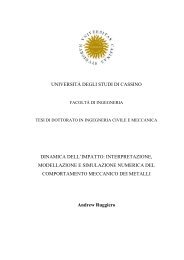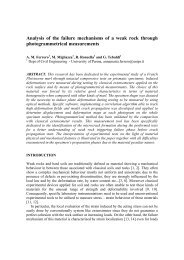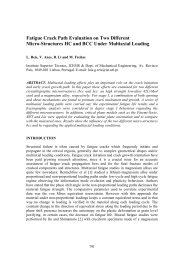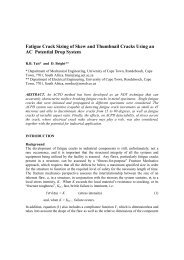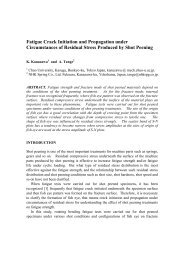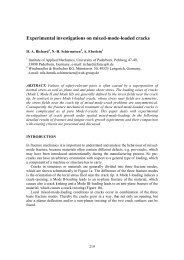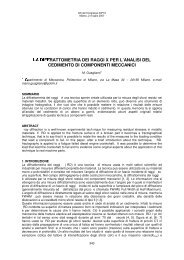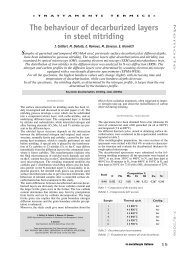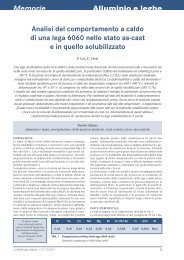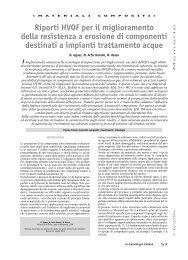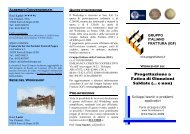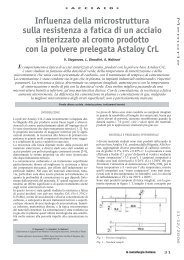Eliminazione del rischio da cromo esavalente nei refrattari esausti ...
Eliminazione del rischio da cromo esavalente nei refrattari esausti ...
Eliminazione del rischio da cromo esavalente nei refrattari esausti ...
Create successful ePaper yourself
Turn your PDF publications into a flip-book with our unique Google optimized e-Paper software.
11-12/2004 Memorie<br />
METALLURGIA FISICA<br />
Nature of metastability Examples<br />
COMPOSITIONAL Supersaturated solutions<br />
STRUCTURAL Intermetallic compounds<br />
Undercooled liquid<br />
Amorphous phases<br />
MORPHOLOGICAL Nanocrystals<br />
AND TOPOLOGICAL Interphase dispersion<br />
Table 1 – Nature of metastability (after reference [2]).<br />
Tabella 1 – Natura <strong>del</strong>la metastabilità (<strong>da</strong>l riferimento [2]).<br />
Method Examples<br />
MELT OR SOLID QUENCH Conventional casting<br />
Rapid solidification<br />
Laser pulse<br />
CONDENSATION Vapour - Gas<br />
Sputtering<br />
Electrodeposition<br />
Chemical deposition<br />
IRRADIATION Particle bombardment<br />
Ion implantation<br />
Ion beam mixing<br />
MECHANICAL Ball milling<br />
COLD WORKING Cold rolling<br />
Pressure<br />
SOLID STATE REACTION Multilayers<br />
Table 2 – Methods for synthesis of metastable structure (after<br />
reference [2]).<br />
Tabella 2 – Metodi di sintesi di strutture metastabili (<strong>da</strong>l<br />
riferimento [2]).<br />
the kinetically preferred path differs from the one most favoured<br />
thermodynamically. It is generally the one requiring<br />
less correlation of atomic positions and motions. Whether a<br />
microstructure is composed of stable equilibrium phases or<br />
metastable phases depends on the nucleation and growth kinetics<br />
of the competing product phases. So, the thermodynamic<br />
description of metastable phases is also necessary to<br />
mo<strong>del</strong> the kinetics of phase transformations.<br />
2<br />
METASTABLE PHASE DIAGRAMS<br />
Phase stability in a particular system is generally represented<br />
in terms of temperature and composition by means of the<br />
phase diagram [3] that can be drawn if the free energy of all<br />
phases is known as a function of temperature and composition.<br />
The equilibrium conditions are reached when the pure<br />
components have the same chemical potential in the different<br />
phases (common tangent rule). Metastable phase diagrams<br />
do not take into account phases, which cannot be produced<br />
for, some kinetic reasons, but consider other phases,<br />
which would not be allowed according to thermodynamics.<br />
As a consequence, in addition to the free energy of stable<br />
phases, the free energy of metastable phases has to be<br />
known. If there are kinetic reasons, which promote metastable<br />
phases, the common tangent rule is applied to the new<br />
equilibria and the phase diagram is modified accordingly<br />
becoming a metastable phase diagram. The major changes<br />
are the elimination of phases, substitution of phases, appearance<br />
of new phases, supercooling or superheating of existing<br />
phases [3].<br />
When possible, metastable phase diagrams are determined<br />
with the same experimental techniques used for the study of<br />
la metallurgia italiana<br />
equilibrium phase diagrams (i.e. thermal analysis, X-ray diffraction,<br />
TEM, SEM, etc.) but, owing to the difficulty in the<br />
experimental determination, they are often calculated. In order<br />
to obtain a metastable phase diagram, it is necessary to<br />
calculate the equilibrium phase diagram and to be able to<br />
extrapolate it to metastable conditions. In general, various<br />
mo<strong>del</strong>s can describe accurately the equilibrium phase diagram,<br />
but extrapolations to metastable conditions may give<br />
quite different results [4]. Phase diagrams can be computed<br />
if experimental <strong>da</strong>ta exist for a given system. Then, a leastsquares<br />
optimisation procedure gives parameters able to describe<br />
the free energy of all phases as a function of temperature<br />
and composition. This is known as CALPHAD approach<br />
[5]. The input <strong>da</strong>ta are the available measured thermodynamic<br />
properties and also experimentally derived portions<br />
of the phase diagram of a given system. The metastable phase<br />
diagram can be calculated simply by extrapolation of the<br />
free energy curves. This procedure is very sensitive to the<br />
analytical description of the thermodynamic functions and<br />
can give wrong results. So, more conveniently, the metastable<br />
phase diagram can be calculated if the input experimental<br />
<strong>da</strong>ta refer directly to metastable phases.<br />
UNDERCOOLED MELTS AND GLASS FORMATION<br />
In order to form a glass, a suitable melt must be undercooled<br />
to the temperature range where it freezes to an amorphous<br />
solid. For glass-forming alloys, the difference in C p between<br />
liquid and solid phases is generally higher with respect to<br />
that of pure metals [6]. The general trend of the liquid specific<br />
heat in glass forming alloys is to increase for increasing<br />
undercooling. An higher value of the specific heat for the liquid<br />
with respect to the crystals would let the entropy of the<br />
liquid phase approach that of the solids quickly on decreasing<br />
the temperature. As the liquid cannot have an entropy<br />
lower than the solid (Kauzmann paradox), the entropy loss<br />
of the liquid on undercooling will stop when the entropy of<br />
both phases is equal (isoentropic temperature, T K ). The liquid<br />
transforms to a glass and the C p of the liquid becomes<br />
equal to that of the solid. This is a common behaviour for<br />
glass-forming materials and the value of T K strongly depends<br />
on the difference in specific heat between liquid and<br />
solid for temperatures lower than T m [7]. T K can be taken as<br />
an approximation of the glass transition temperature, T g .<br />
T 0 CURVES<br />
The T 0 curve is the locus of the compositions and temperatures<br />
where the free energies of two phases are equal. The T 0<br />
curve between the liquid and a solid phase determines the<br />
minimum undercooling of the liquid for the partition-less<br />
formation of the solid with the same composition [8]. For an<br />
estimation of the T 0 curve, the free energy of liquid and solid<br />
phases as a function of composition and temperature must<br />
be known.<br />
Examples are provided in figure 2 for a eutectic system. T 0<br />
curves can be confidently extrapolated at temperatures below<br />
the horizontal, where they define the temperature-composition<br />
field for partitionless solidification. Alloys with T 0 curves<br />
which are only slightly depressed below the stable liquidus<br />
curves are good candi<strong>da</strong>tes for partitionless solidification<br />
in the entire composition range (<strong>da</strong>shed lines in figure 2). If<br />
T 0 curves plunge to very low temperatures (thick continuous<br />
lines in figure 2), single phase crystals cannot be formed<br />
from the melt. In this region, the kinetics of solid phase separation<br />
from the undercooled liquid depresses the solidification<br />
temperature toward T g , where an increased liquid viscosity<br />
halts crystallization, so that a glass may be formed.



